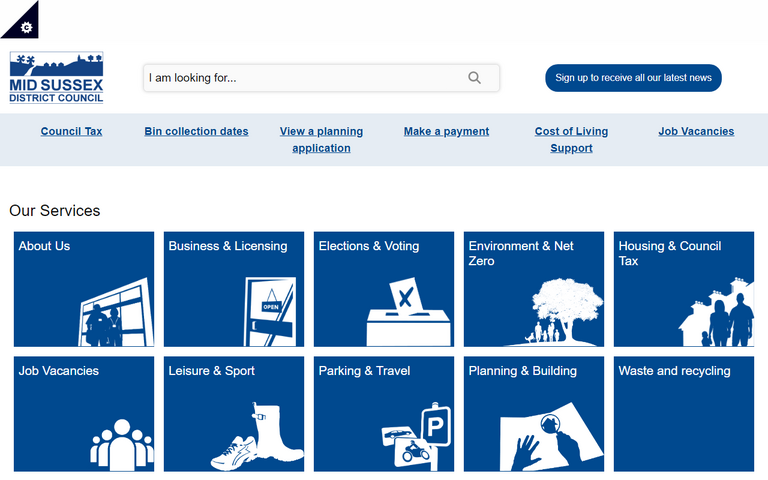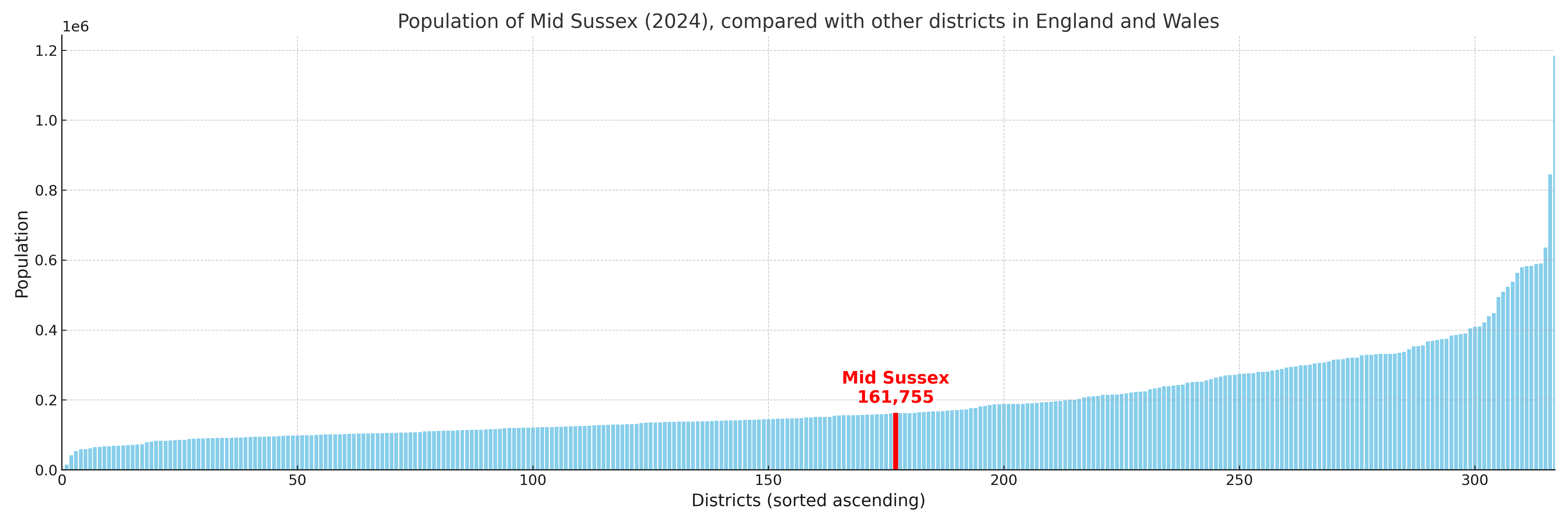Mid Sussex
§ This page gives an overview of the Mid Sussex local authority district, bringing together key facts, maps, and data to help you quickly understand the area. One of 361 district profiles on Baseview.
Overview ⁞ Mid Sussex, between London and the South Downs, combines market towns, villages, and countryside. Haywards Heath is the main centre, while Burgess Hill and East Grinstead add suburban character. The Ashdown Forest, linked with A.A. Milne’s Winnie-the-Pooh, offers heathland and woodlands. The South Downs National Park provides hills, chalk downs, and scenic valleys to the south. Rivers, farmland, and historic villages complete the district’s varied landscape.
Mid Sussex Boundary Map
This map shows the official boundary of the Mid Sussex local authority district, based on the latest geographic data published by the Office for National Statistics (ONS). It provides a clear view of the district’s extent and helps you understand how the area fits within the wider regional and national landscape.
Contains OS data © Crown copyright and database right 2025. Source: Office for National Statistics licensed under the Open Government Licence v3.0.
The administrative boundary of Mid Sussex can also be viewed on OpenStreetMap: District Boundary of Mid Sussex.
Key Facts about Mid Sussex
What region is Mid Sussex in? Mid Sussex is in the South East of England, a region within the UK.
What county is Mid Sussex in? Mid Sussex is located in the county of West Sussex.
Is Mid Sussex a city? No, Mid Sussex is not a city. (Note: the UK has 76 officially designated cities.)
Who governs Mid Sussex? The local authority for this district is: Mid Sussex District Council - responsible for district-level services. Since West Sussex is a two-tier area, county-level services are handled by: West Sussex County Council.
▶ Official website of Mid Sussex District Council 🔗 midsussex.gov.uk

Which police force covers Mid Sussex? Policing in Mid Sussex is provided by Sussex Police 🔗 sussex.police.uk, which serves 13 local authority districts: Adur ⁞ Arun ⁞ Brighton and Hove ⁞ Chichester ⁞ Crawley ⁞ Eastbourne ⁞ Hastings ⁞ Horsham ⁞ Lewes ⁞ Mid Sussex ⁞ Rother ⁞ Wealden ⁞ Worthing.
Constituencies in Mid Sussex
Mid Sussex is divided into 2 parliamentary constituencies, listed below in alphabetical order.
A constituency is a specific geographical area that elects one Member of Parliament (MP) to represent them in the House of Commons. The United Kingdom is divided into 650 parliamentary constituencies. We have this list page for easy browsing of all UK parliamentary constituencies: List of Constituencies.
Wards in Mid Sussex
Mid Sussex is divided into 27 wards, listed below in alphabetical order.
- Ardingly, Balcombe & Turners Hill
- Ashurst Wood & East Grinstead South
- Burgess Hill Dunstall
- Burgess Hill Franklands
- Burgess Hill Leylands
- Burgess Hill Meeds & Hammonds
- Burgess Hill St Andrews
- Burgess Hill Victoria
- Copthorne & Worth
- Crawley Down
- Cuckfield, Bolney & Ansty
- Downland Villages
- East Grinstead Ashplats
- East Grinstead Baldwins
- East Grinstead Herontye
- East Grinstead Imberhorne
- East Grinstead Town
- Handcross & Pease Pottage
- Hassocks
- Haywards Heath Ashenground
- Haywards Heath Bentswood & Heath
- Haywards Heath Franklands
- Haywards Heath Lucastes & Bolnore
- Haywards Heath North
- Hurstpierpoint
- Lindfield
- Lindfield Rural & High Weald
In the UK, a ward is a subdivision of a local authority area, used mainly for electoral and statistical purposes. Defined by the ONS, wards represent the primary unit for local elections, each returning one or more councillors to the local council. Wards are also used as a key geography for presenting population and census data.
Parishes in Mid Sussex
Mid Sussex is fully parished: 24 civil parishes, listed A-Z below.
- Albourne
- Ansty and Staplefield
- Ardingly
- Ashurst Wood
- Balcombe
- Bolney
- Burgess Hill
- Cuckfield
- East Grinstead
- Fulking
- Hassocks
- Haywards Heath
- Horsted Keynes
- Hurstpierpoint and Sayers Common
- Lindfield
- Lindfield Rural
- Newtimber
- Poynings
- Pyecombe
- Slaugham
- Turners Hill
- Twineham
- West Hoathly
- Worth
A civil parish is the lowest tier of local government in England, used for villages, small towns, and suburbs. They have their own local authority, either a parish council or a parish meeting, which provides local services like managing parks, allotments, and streetlights, and represents the community's views to larger councils.
Built-up Areas in Mid Sussex
Mid Sussex covers 28 built-up areas, listed below in alphabetical order.
- Albourne
- Ansty
- Ardingly
- Ashurst Wood *
- Balcombe
- Bolney
- Burgess Hill *
- Copthorne *
- Crawley (Crawley) *
- Crawley Down
- Cuckfield
- East Grinstead *
- Felbridge *
- Fulking
- Furnace Wood *
- Handcross
- Hassocks and Hurstpierpoint *
- Haywards Heath *
- Horsted Keynes
- Pease Pottage *
- Sayers Common
- Scayne's Hill
- Sharpthorne *
- Staplefield
- Turners Hill
- Warninglid
- West Hoathly
- Worth Abbey
In the UK, a Built-up Area (BUA) is a continuous urban area of at least 20 hectares (0.2 km²), defined by the ONS as land where buildings are generally no more than 200 metres apart, such as towns, cities, or large villages. (Note: A BUA name marked with an asterisk (*) indicates that the area is situated partly in the district of Mid Sussex.)
Mid Sussex compared with other districts in the UK
This section shows how Mid Sussex compares with other local authority districts in the UK, using a variety of measures and rankings.
Mid Sussex has 27 electoral wards.

Mid Sussex has a population of 161,755 (2024 mid-year estimate by ONS)

More local statistics and data for Mid Sussex can be found on the ONS statistics for Mid Sussex.